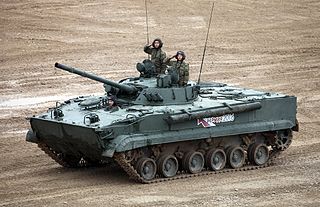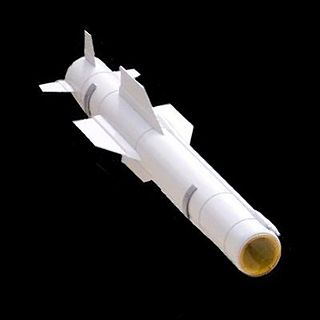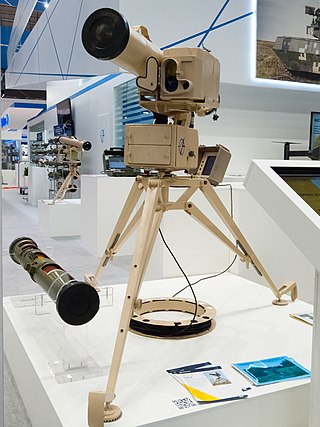
An anti-tank guided missile (ATGM), anti-tank missile, anti-tank guided weapon (ATGW) or anti-armor guided weapon is a guided missile primarily designed to hit and destroy heavily armored military vehicles. ATGMs range in size from shoulder-launched weapons, which can be transported by a single soldier, to larger tripod-mounted weapons, which require a squad or team to transport and fire, to vehicle and aircraft mounted missile systems.

The BMP-3 is a Soviet and Russian infantry fighting vehicle, successor to the BMP-1 and BMP-2. The abbreviation BMP stands for Boevaya Mashina Pekhoty.

The Mil Mi-24 is a large helicopter gunship, attack helicopter and low-capacity troop transport with room for eight passengers. It is produced by Mil Moscow Helicopter Plant and was introduced by the Soviet Air Force in 1972. The helicopter is currently in use by 58 countries.

The Mil Mi-28 is a Soviet all-weather, day-night, military tandem, two-seat anti-armor attack helicopter. It is an attack helicopter with no intended secondary transport capability, and is better optimized than the Mil Mi-24 gunship for the role. It carries a single gun in an undernose barbette, plus external loads carried on pylons beneath stub wings.

The 3M11Fleyta is a Soviet MCLOS radio command anti-tank missile. Various improved versions were designated 9M17Falanga.

9K114 Shturm – is a SACLOS radio guided anti-tank missile system of the Soviet Union. Its GRAU designation is 9K114. Its NATO reporting name is AT-6 Spiral. The missile itself is known as the 9M114 Kokon (Cocoon).

The PARS 3 LR in German service, also known as TRIGAT-LR and AC 3G in French, is a fire-and-forget missile, which can be used against air or ground targets. It is intended for long range applications and designed to defeat tanks, helicopters and other individual targets, while minimizing the exposure of the launch vehicle to enemy fire. It is to be the main weapon system of the Eurocopter Tiger helicopter. The PARS 3 LR will be able to be fired in salvos of up to four in eight seconds. The missile can be applied in direct attack or top-attack modes.

The 9K112 Kobra is a SACLOS anti-tank missile system of the Soviet Union. It is fired from the 125 mm main guns of the T-64 and T-80 series of tanks. A newer design based on the same concept is the 9M119.

The 9K120 Svir, 9K119 Refleks, 9K119M Refleks-M are laser beam riding, guided anti-tank missile systems developed in the Soviet Union. Both are designed to be fired from smoothbore 125 mm tank and anti-tank guns. The name Svir comes from the River Svir, while Refleks means reflex.

The 9M123 Khrizantema is a Russian anti-tank guided missile (ATGM). Khrizantema was designed to deal with current and future generations of main battle tanks and can also be used to engage slow and low flying aerial targets like helicopters. The 9M123 missile, and its associated guidance system, forms the 9K123 missile system.

The 9K121 Vikhr is a Soviet laser-beam-riding anti-tank missile. "9K121" is the GRAU designation for the missile system. The missile can be launched from warships, Ka-50 and Ka-52 helicopters, and Su-25T aircraft, and has a range of approximately 10km. It was first shown publicly at the 1992 Farnborough Airshow.

The BMPT "Terminator" is an armored fighting vehicle (AFV), designed and manufactured by the Russian company Uralvagonzavod. This vehicle was designed for supporting tanks and other AFVs in urban areas. The BMPT is unofficially named the "Terminator" by the manufacturers. It is heavily armed and armored to survive in urban combat. The AFV is armed with four 9M120 Ataka missile launchers, two 30 mm 2A42 autocannons, two AG-17D grenade launchers, and one coaxial 7.62 mm PKTM machine gun.
KB Mashinostroyeniya or KBM for short is a state defence enterprise, scientific and design R&D centre specialised in missile systems located in Kolomna, Moscow region, Russia. Part of Rostec state corporation.
The 2T Stalker, also known as BM-2T Stalker, is a Belarusian armoured vehicle. it is a part of the GM chassis and It never entered production.

The 9M133M Kornet-M Russian anti-tank guided missile (ATGM) is an improved version of the 9M133 Kornet ATGM, with increased range and an improved warhead.

The Skif, also known as the Stugna-P or Stuhna-P, is a Ukrainian anti-tank guided missile (ATGM) system developed in the early 2010s by the Luch Design Bureau, a unit of UkrOboronProm. The initial guidance device PN-S (ПН-С) of the Skif was developed and manufactured by Belarusian design bureau Peleng based in Minsk.

The LMUR is a Russian helicopter-launched air-to-surface missile. It is also recognized under the alternative designations Izdeliye 305 and 9A-7755.



















